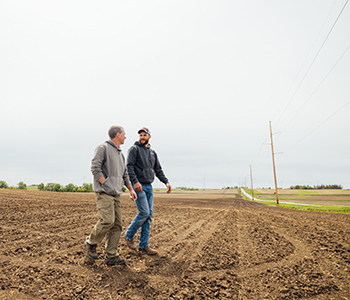How to Measure Soil Health
Mar 20, 2023

Landon Van Dyke
Sales Agronomist
HOW CAN YOU tell if your soil is healthy? It’s the million-dollar question all farmers think about. Healthy soil is fundamental to every farming operation. Each year, we take measures to keep our soils healthy. Strategies will look different for each operation, but we should all measure soil health by three categories: chemical, physical and biological. Let's highlight the most important aspects within each category.
Chemical measurements are the most common type done on row crop operations. This is what most people are referring to when they mention soil sampling. This process includes measuring pH, macronutrients (N, P, K, S) and micronutrients (Zn, B, Mg, Fe, etc.). This category is extensively measured on almost every acre.
Physical measurements include water holding capacity, compaction and aggregate stability. These measurements look at the structure of your soil. Compaction impacts yields by not allowing the proper ratio of air into the soil, limiting root growth and nutrient uptake to the plant. Water holding capacity defines how much or how little water can be held in the soil. It is directly linked to soil texture, but it can also be influenced by organic matter and aggregate stability. Aggregate stability measures how well the soil particles hold together when they’re impacted by tillage and erosion. The better the particles hold together the more stable the soil is, boosting yield potential.
The final category is biological measurements. There are many components to this category, but the main ones are active carbon, organic matter and respiration. Organic matter is a common soil test evaluation. The problem with only looking at organic matter is that this component has a delayed response and gives an incomplete view. That's why it's commonly said that sustainable practices take too long to make an impact. As a result, it's important to also look at active carbon. Active carbon is the portion of soil carbon that is actively decomposing; it is the microbe's food source and respiration. The best component to look at is respiration because it gives the most comprehensive indication of what's going on in the soil biologically. Respiration measures how much CO2 is released by microbes to result in a higher rate. This process requires more active carbon (food) for the microbes to release ad-ditional CO2, which will eventually lead to increased organic matter.
If you are not currently measuring all three categories, now is the time to reach out to your local Key Agronomist. We’ll help you get more detailed insights into your soil health for better yields.
Sales Agronomist
HOW CAN YOU tell if your soil is healthy? It’s the million-dollar question all farmers think about. Healthy soil is fundamental to every farming operation. Each year, we take measures to keep our soils healthy. Strategies will look different for each operation, but we should all measure soil health by three categories: chemical, physical and biological. Let's highlight the most important aspects within each category.
Chemical measurements are the most common type done on row crop operations. This is what most people are referring to when they mention soil sampling. This process includes measuring pH, macronutrients (N, P, K, S) and micronutrients (Zn, B, Mg, Fe, etc.). This category is extensively measured on almost every acre.
Physical measurements include water holding capacity, compaction and aggregate stability. These measurements look at the structure of your soil. Compaction impacts yields by not allowing the proper ratio of air into the soil, limiting root growth and nutrient uptake to the plant. Water holding capacity defines how much or how little water can be held in the soil. It is directly linked to soil texture, but it can also be influenced by organic matter and aggregate stability. Aggregate stability measures how well the soil particles hold together when they’re impacted by tillage and erosion. The better the particles hold together the more stable the soil is, boosting yield potential.
The final category is biological measurements. There are many components to this category, but the main ones are active carbon, organic matter and respiration. Organic matter is a common soil test evaluation. The problem with only looking at organic matter is that this component has a delayed response and gives an incomplete view. That's why it's commonly said that sustainable practices take too long to make an impact. As a result, it's important to also look at active carbon. Active carbon is the portion of soil carbon that is actively decomposing; it is the microbe's food source and respiration. The best component to look at is respiration because it gives the most comprehensive indication of what's going on in the soil biologically. Respiration measures how much CO2 is released by microbes to result in a higher rate. This process requires more active carbon (food) for the microbes to release ad-ditional CO2, which will eventually lead to increased organic matter.
If you are not currently measuring all three categories, now is the time to reach out to your local Key Agronomist. We’ll help you get more detailed insights into your soil health for better yields.